
A trail, also known as a path or track, is an unpaved lane or a small paved road not intended for usage by motorized vehicles, usually passing through a natural area. In the United Kingdom and the Republic of Ireland, a path or footpath is the preferred term for a pedestrian or hiking trail. The term is also applied in North America to accompanying routes along rivers, and sometimes to highways. In the US, the term was historically used for a route into or through wild territory used by explorers and migrants. In the United States, "trace" is a synonym for trail, as in Natchez Trace.

The European long-distance paths (E-paths) are a network of long-distance footpaths that traverse Europe. While most long-distance footpaths in Europe are located in just one country or region, each of these numbered European long-distance paths passes through many countries.

EuroVelo is a network of 17 long-distance cycling routes criss-crossing Europe, in various stages of completion. When completed, the EuroVelo network's total length will almost be 90,000 km (55,923 mi). As of November 2022 more than 56,000 km (34,797 mi) were in place. EuroVelo is a project of the European Cyclists' Federation (ECF).

A rail trail is a shared-use path on railway right of way. Rail trails are typically constructed after a railway has been abandoned and the track has been removed but may also share the right of way with active railways, light rail, or streetcars, or with disused track. As shared-use paths, rail trails are primarily for non-motorized traffic including pedestrians, bicycles, horseback riders, skaters, and cross-country skiers, although snowmobiles and ATVs may be allowed. The characteristics of abandoned railways—gentle grades, well-engineered rights of way and structures, and passage through historical areas—lend themselves to rail trails and account for their popularity. Many rail trails are long-distance trails, while some shorter rail trails are known as greenways or linear parks.

The European Cyclists' Federation (ECF) is a non-profit member-based umbrella federation of local, regional and national civil society organizations that promote cycling for both transportation and leisure.

A greenway is usually a shared-use path along a strip of undeveloped land, in an urban or rural area, set aside for recreational use or environmental protection. Greenways are frequently created out of disused railways, canal towpaths, utility company rights of way, or derelict industrial land. Greenways can also be linear parks, and can serve as wildlife corridors. The path's surface may be paved and often serves multiple users: walkers, runners, bicyclists, skaters and hikers. A characteristic of greenways, as defined by the European Greenways Association, is "ease of passage": that is that they have "either low or zero gradient", so that they can be used by all "types of users, including mobility impaired people".

EuroVelo 12 (EV12), the North Sea Cycle Route, is a 5,942 km (3,692 mi) long-distance cycling route circuit around the coastlines of the countries that border the North Sea: these countries are England, Scotland, Norway, Sweden, Denmark, Germany, the Netherlands and Belgium.
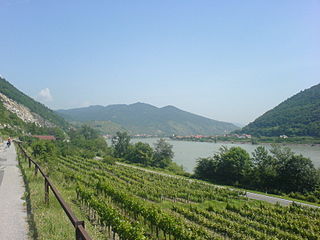
EuroVelo 6 (EV6), named the "Rivers Route", is a EuroVelo long-distance cycling route that runs along 3,653 km (2,270 mi) some of Europe's major rivers, including much of the Loire, some of the Saône, a short section of the upper Rhine and almost the entire length of Europe’s second longest river, the Danube — from the Atlantic coast of France to the city of Constanța on the Black Sea.
The Route Verte is a network of bicycling and multiuse trails and designated roads, lanes, and surfaces, spanning 5,034 kilometres (3,128 mi) as of October 31, 2013, in the Canadian province of Quebec, inaugurated on August 10, 2007. The trail network includes both urban trails and cycling routes into quite isolated areas in the north, as well as along both sides of the Saint Lawrence River, out to the Gaspésie region, and on the Magdalen Islands, linking more than 320 municipalities along the way. The Route Verte is not entirely composed of trails, as nearly 61% of the network actually consists of on-road surfaces, whether regular roads with little traffic, wide shoulders, special lanes on highways, or otherwise. The segregated trails are mostly rail trails shared-use with hikers and other users.

A long-distance trail is a longer recreational trail mainly through rural areas used for hiking, backpacking, cycling, horse riding or cross-country skiing. They exist on all continents except Antarctica.

Cycling in Minnesota is a popular form of recreation, commuting, and competitive sport that has grown in prominence over the years. It has been a popular activity in the state since the late 19th century.

Cycling in Canada is experienced in various ways across a geographically huge, economically and socially diverse country. Among the reasons for cycling in Canada are for practical reasons such as commuting to work or school, for sports such as road racing, BMX, mountain bike racing, freestyle BMX, as well as for pure recreation. The amount and quality of bicycle infrastructure varies widely across the country as do the laws pertaining to cyclists such as bicycle helmet laws which can differ by province.
LF-Routes are long-distance cycling routes that form a network in the Netherlands and Belgium. The routes, criss-crossing both countries, are primarily intended for recreational multi-day bike tours, such as cycling holidays. Some routes are also part of a wider international network.
A national cycling route network is a nationwide network of designated long-distance cycling routes found in various countries around the world for the purposes of bicycle tourism. They are often created and maintained by the government of the country, or at least with the backing or co-operation of the government of the country. Some of the routes in these national networks can be part of international long-distance cycling routes, such as the EuroVelo network of European cycling routes.

The German Cycling Network is the national cycling route network of Germany. There are currently 12 such long-distance cycling routes, called D-Routes criss-crossing the German nation and these were established mainly to promote bicycle tourism.
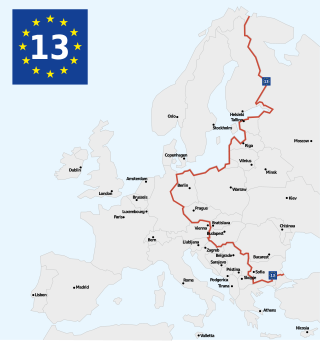
The Iron Curtain Trail (ICT), also known as EuroVelo 13 (EV13), is a partially complete long-distance cycling route which will run along the entire length of the former Iron Curtain. During the period of the Cold War, the Iron Curtain delineated the border between the Communist East and the capitalist West, with the East being the Warsaw Pact countries of the Soviet bloc and the West being the countries of NATO.
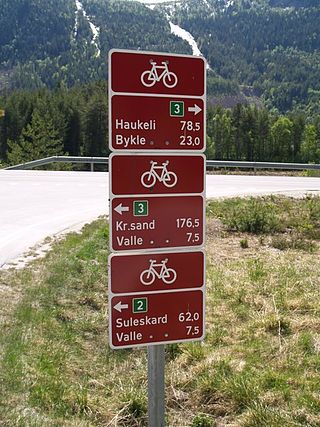
The Norwegian National Cycle Routes form the national cycling route network of Norway. There are currently 10 such long-distance cycling routes, criss-crossing Norway and these were established mainly to promote bicycle tourism.
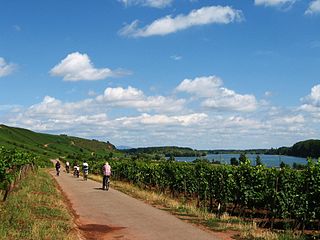
EuroVelo 15 (EV15), named the Rhine Cycle Route, is a EuroVelo long-distance cycling route running 1230km along the Rhine river valley from the headwaters of the Rhine in Andermatt in Switzerland to the river's mouth in Hook of Holland in the Netherlands. The route crosses Europe from south to north, from the Swiss Alps to the North Sea, passing through four countries: Switzerland, France, Germany and the Netherlands.
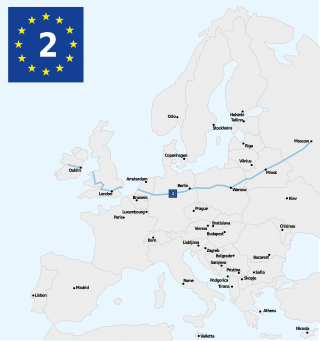
EuroVelo 2 (EV2), named The Capitals Route, is a 5,500 km (3,400 mi) long EuroVelo long-distance cycling route running from Galway, Ireland to Moscow, Russia. This east-west route passes successively through seven countries – Ireland, the United Kingdom, the Netherlands, Germany, Poland, Belarus and Russia – and visits all their capital cities.

Cycling in Turkey is held back by poor infrastructure. It is sometimes done for health reasons, and infrastructure is being improved. The World Health Organization has called for transport in Turkey to include more active transport such as cycling.
















